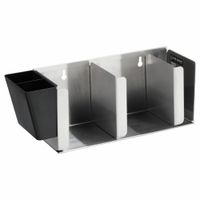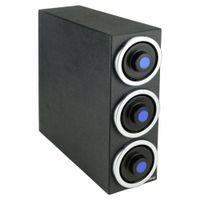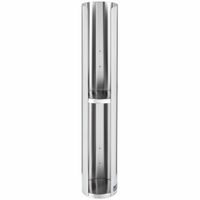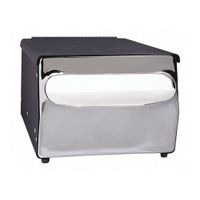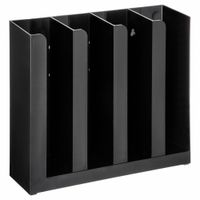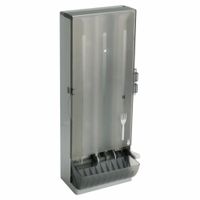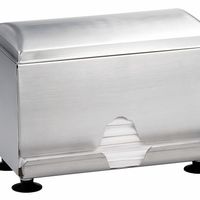Call +(254) 703 030 000 / 751 483 999 / 721 704 777
- Home
- Furnishings Appliances Hospitality
- Breakroom Food Service Disposables
- Dispensers For Food Service Disposables
Frequently Asked Questions
What are the benefits of using dispensers for food service disposables?
Using dispensers for food service disposables offers several benefits:
1. **Hygiene and Sanitation**: Dispensers minimize direct contact with disposable items, reducing the risk of contamination and promoting a more sanitary environment. This is crucial in food service settings where maintaining cleanliness is paramount.
2. **Cost Efficiency**: Dispensers help control the amount of disposables used by dispensing one item at a time. This reduces waste and ensures that customers and staff use only what is necessary, leading to cost savings.
3. **Organization and Accessibility**: Dispensers keep disposables neatly organized and easily accessible. This improves the efficiency of service as staff and customers can quickly find and retrieve the items they need without rummaging through cluttered supplies.
4. **Space Saving**: By consolidating items into a single unit, dispensers save counter and storage space. This is particularly beneficial in small or busy food service areas where space is at a premium.
5. **Improved Customer Experience**: A well-organized dispenser system enhances the customer experience by providing a clean, efficient, and user-friendly way to access disposables. This can lead to increased customer satisfaction and repeat business.
6. **Environmental Impact**: By reducing waste through controlled dispensing, businesses can lessen their environmental footprint. Some dispensers are also designed to accommodate eco-friendly disposables, further supporting sustainability efforts.
7. **Brand Image**: Using dispensers can enhance a business's image by demonstrating a commitment to hygiene, efficiency, and environmental responsibility. This can be a competitive advantage in the food service industry.
8. **Durability and Maintenance**: High-quality dispensers are durable and require minimal maintenance, providing a long-term solution for managing disposables effectively.
Overall, dispensers offer practical, economic, and environmental advantages that can significantly benefit food service operations.
How do Dixie Ultra SmartStock cutlery dispensers work?
Dixie Ultra SmartStock cutlery dispensers are designed to provide a hygienic, efficient, and organized way to dispense cutlery in high-traffic food service environments. These dispensers work by utilizing a gravity-fed system that allows users to easily access one piece of cutlery at a time, reducing waste and minimizing contact with other utensils.
Each dispenser is specifically designed for a type of cutlery—forks, knives, or spoons—and is loaded with pre-packaged refill cartridges. These cartridges are easy to install and replace, ensuring a continuous supply of cutlery. The dispensers are typically made of durable plastic and feature a transparent front, allowing staff to quickly see when a refill is needed.
The operation is straightforward: users simply pull the handle or press a lever, depending on the model, to release a single piece of cutlery. This single-dispense mechanism helps maintain hygiene by preventing users from touching multiple utensils, thus reducing the risk of cross-contamination.
The dispensers are designed to be compact and can be mounted on countertops or walls, saving space and keeping the serving area tidy. They are also designed to be tamper-resistant, ensuring that the cutlery remains clean and secure until dispensed.
Overall, Dixie Ultra SmartStock cutlery dispensers streamline the process of distributing cutlery, enhance cleanliness, and improve operational efficiency in food service settings.
What types of disposable cup dispensers are available?
There are several types of disposable cup dispensers available, each designed to accommodate different needs and settings:
1. **Gravity-fed Dispensers**: These are the most common type, using gravity to dispense cups. They are typically mounted on walls or counters and are suitable for high-traffic areas. Cups are stacked vertically, and users pull the bottom cup out.
2. **Spring-loaded Dispensers**: These dispensers use a spring mechanism to push cups forward. They are ideal for maintaining a consistent dispensing speed and are often used in fast-paced environments like cafeterias and fast-food restaurants.
3. **In-counter Dispensers**: Installed directly into countertops, these dispensers save space and provide a clean, integrated look. They are often used in self-service beverage stations.
4. **Surface-mounted Dispensers**: These are attached to walls or other surfaces and are suitable for areas with limited counter space. They can be used for both vertical and horizontal dispensing.
5. **Freestanding Dispensers**: These portable units can be placed anywhere, making them versatile for events or temporary setups. They often have multiple compartments for different cup sizes.
6. **Adjustable Dispensers**: Designed to accommodate various cup sizes, these dispensers have adjustable mechanisms to hold different diameters securely. They are useful in environments where multiple cup sizes are used.
7. **Sanitary Shield Dispensers**: Equipped with a protective shield, these dispensers minimize contact with the cups, enhancing hygiene. They are popular in healthcare and food service settings.
8. **Touchless Dispensers**: Utilizing sensors, these dispensers allow users to obtain a cup without touching the dispenser, promoting hygiene and reducing the spread of germs.
Each type of dispenser is designed to meet specific needs, such as space constraints, hygiene requirements, or the need for versatility in cup sizes.
How can I choose the right lid dispenser for my business?
To choose the right lid dispenser for your business, consider the following factors:
1. **Type of Lids**: Identify the types of lids you use (e.g., flat, dome, or specialty lids) and ensure the dispenser is compatible with them.
2. **Volume and Capacity**: Assess your business's volume of lid usage. High-traffic areas may require dispensers with larger capacities to minimize refilling frequency.
3. **Material and Durability**: Choose a dispenser made from durable materials like stainless steel or high-quality plastic to withstand frequent use and potential spills.
4. **Design and Aesthetics**: Consider the design and appearance of the dispenser to ensure it complements your business's decor and branding.
5. **Ease of Use**: Opt for a dispenser that is easy to load, use, and maintain. Features like clear visibility of remaining lids and simple dispensing mechanisms can enhance user experience.
6. **Space and Placement**: Evaluate the available space for the dispenser. Wall-mounted, countertop, or under-counter options can help optimize space usage.
7. **Hygiene and Cleanliness**: Ensure the dispenser design minimizes lid exposure to contaminants and is easy to clean, promoting hygiene.
8. **Cost and Budget**: Balance quality and cost. While initial investment is important, consider long-term durability and maintenance costs.
9. **Brand Reputation and Reviews**: Research brands and read customer reviews to gauge reliability and performance.
10. **Customization Options**: Some dispensers offer customization for branding or specific operational needs, which can enhance customer experience.
By considering these factors, you can select a lid dispenser that meets your operational needs, enhances efficiency, and aligns with your business's aesthetic and functional requirements.
What features should I look for in a napkin dispenser?
When selecting a napkin dispenser, consider the following features:
1. **Capacity**: Choose a dispenser that matches your usage needs. High-capacity dispensers are ideal for busy environments, while smaller ones suit less frequent use.
2. **Material**: Look for durable materials like stainless steel or high-quality plastic that can withstand frequent use and are easy to clean.
3. **Design**: Consider the aesthetic appeal and how it fits with your décor. Options range from sleek and modern to classic and traditional.
4. **Dispensing Mechanism**: Opt for a dispenser that offers easy, one-at-a-time dispensing to minimize waste and ensure hygiene.
5. **Refill Ease**: Ensure the dispenser is easy to refill, with a straightforward mechanism that doesn’t require complex disassembly.
6. **Size and Space**: Consider the available space and choose a dispenser that fits comfortably without overcrowding the area.
7. **Mounting Options**: Decide between countertop, wall-mounted, or freestanding models based on your space and convenience needs.
8. **Hygiene**: Look for features that promote hygiene, such as touchless operation or antimicrobial surfaces.
9. **Cost**: Balance your budget with the features you need. While initial costs are important, consider long-term savings from reduced napkin waste.
10. **Brand and Reviews**: Research brands known for quality and reliability, and read customer reviews to gauge performance and satisfaction.
11. **Compatibility**: Ensure the dispenser is compatible with the napkin size and type you plan to use.
12. **Security**: In public settings, consider dispensers with locking mechanisms to prevent theft or tampering.
By evaluating these features, you can select a napkin dispenser that meets your functional needs and complements your environment.
Are combination dispensers more efficient than individual dispensers?
Combination dispensers can be more efficient than individual dispensers in several ways. They consolidate multiple products into a single unit, saving space and reducing clutter, which is particularly beneficial in environments with limited space, such as small bathrooms or kitchens. This consolidation can also streamline the refilling process, as maintenance staff or users only need to manage one unit instead of several, potentially reducing labor time and costs.
Additionally, combination dispensers can enhance user convenience by providing multiple products in one location, reducing the need for users to move between different dispensers. This can improve the user experience, particularly in high-traffic areas like public restrooms or commercial kitchens.
From a cost perspective, combination dispensers may offer savings in terms of initial purchase and installation costs, as buying and installing a single unit can be cheaper than multiple individual units. They may also reduce waste, as they often come with refillable options that minimize packaging waste compared to single-use dispensers.
However, the efficiency of combination dispensers can depend on the specific context and needs. In some cases, individual dispensers might be more suitable, especially if different products have varying usage rates or if there is a need for flexibility in product placement. Additionally, if one component of a combination dispenser fails, it might render the entire unit unusable until repaired, whereas individual dispensers can be independently maintained.
Overall, while combination dispensers can offer significant efficiency advantages in terms of space, cost, and user convenience, their effectiveness depends on the specific application and environment.
How do I maintain and clean dispensers for food service disposables?
To maintain and clean dispensers for food service disposables, follow these steps:
1. **Regular Inspection**: Frequently check dispensers for any signs of damage or malfunction. Ensure that all parts are intact and functioning properly.
2. **Empty Dispensers**: Before cleaning, remove all disposables from the dispenser. This prevents contamination and allows for thorough cleaning.
3. **Disassemble**: If possible, disassemble the dispenser according to the manufacturer's instructions. This allows you to clean each component individually.
4. **Cleaning Solution**: Prepare a mild cleaning solution using warm water and a gentle detergent. Avoid harsh chemicals that could damage the dispenser or leave residues.
5. **Wipe Down**: Use a soft cloth or sponge to wipe down all surfaces of the dispenser. Pay special attention to areas that come into contact with disposables, as these are prone to accumulating dirt and bacteria.
6. **Rinse**: Rinse all parts thoroughly with clean water to remove any soap residue. This is crucial to prevent contamination of the disposables.
7. **Dry**: Allow all parts to air dry completely or use a clean, dry cloth. Ensure no moisture remains, as this can lead to mold or bacterial growth.
8. **Reassemble**: Once all parts are dry, reassemble the dispenser carefully. Ensure all components are securely in place.
9. **Sanitize**: Use a food-safe sanitizer to spray or wipe down the dispenser, focusing on high-touch areas. Follow the sanitizer's instructions for contact time to ensure effectiveness.
10. **Refill**: Once the dispenser is clean and dry, refill it with fresh disposables. Ensure they are stored in a clean, dry area to maintain hygiene.
11. **Routine Maintenance**: Establish a regular cleaning schedule based on usage frequency. High-traffic areas may require daily cleaning, while others may need weekly attention.
By following these steps, you can ensure that your dispensers remain clean, functional, and safe for use in food service environments.
